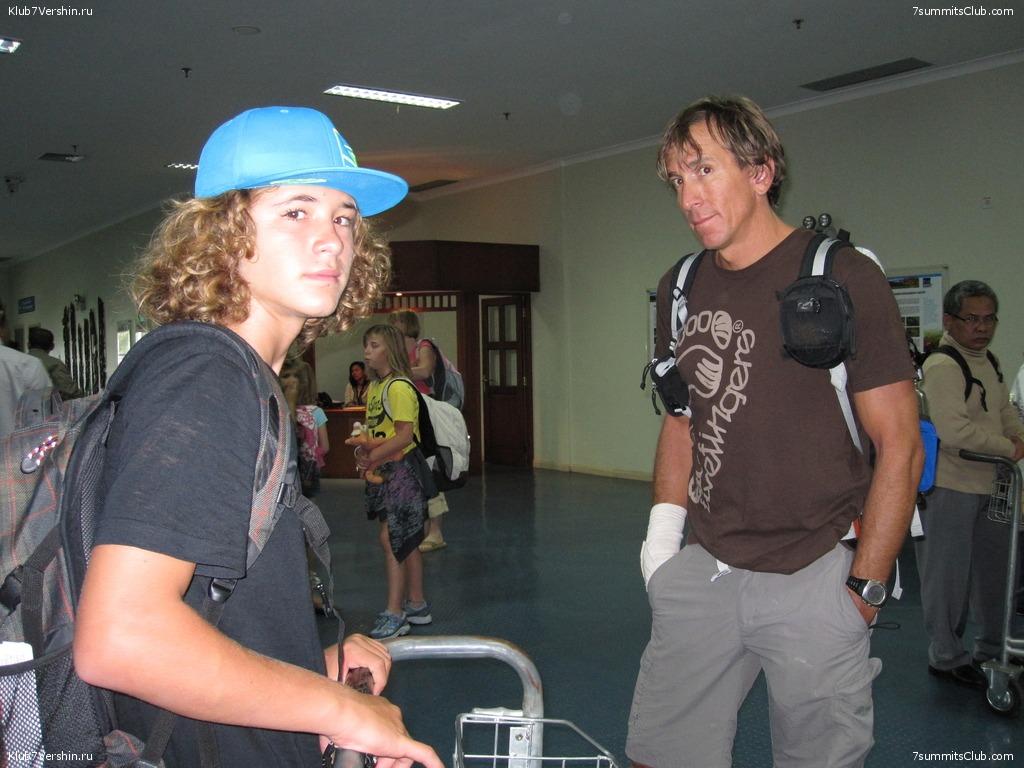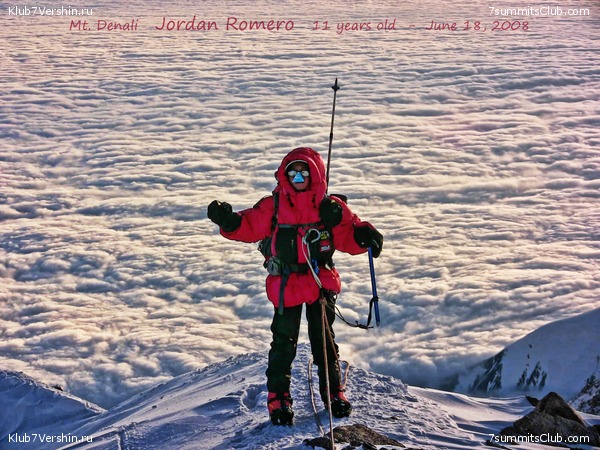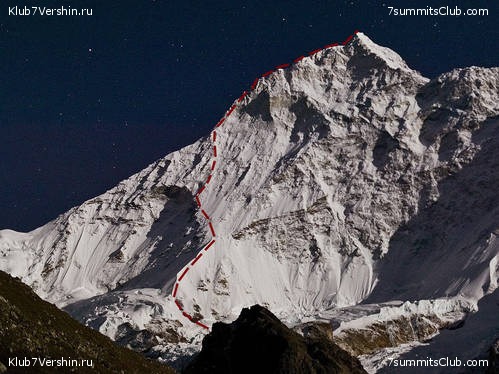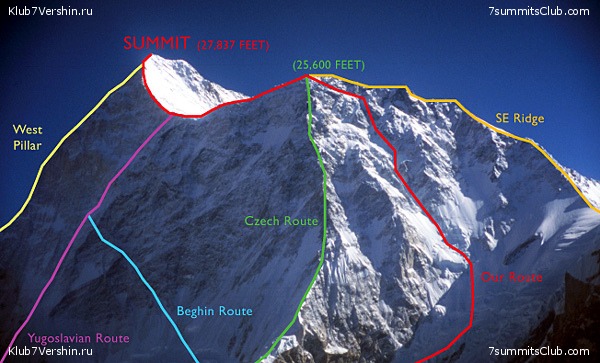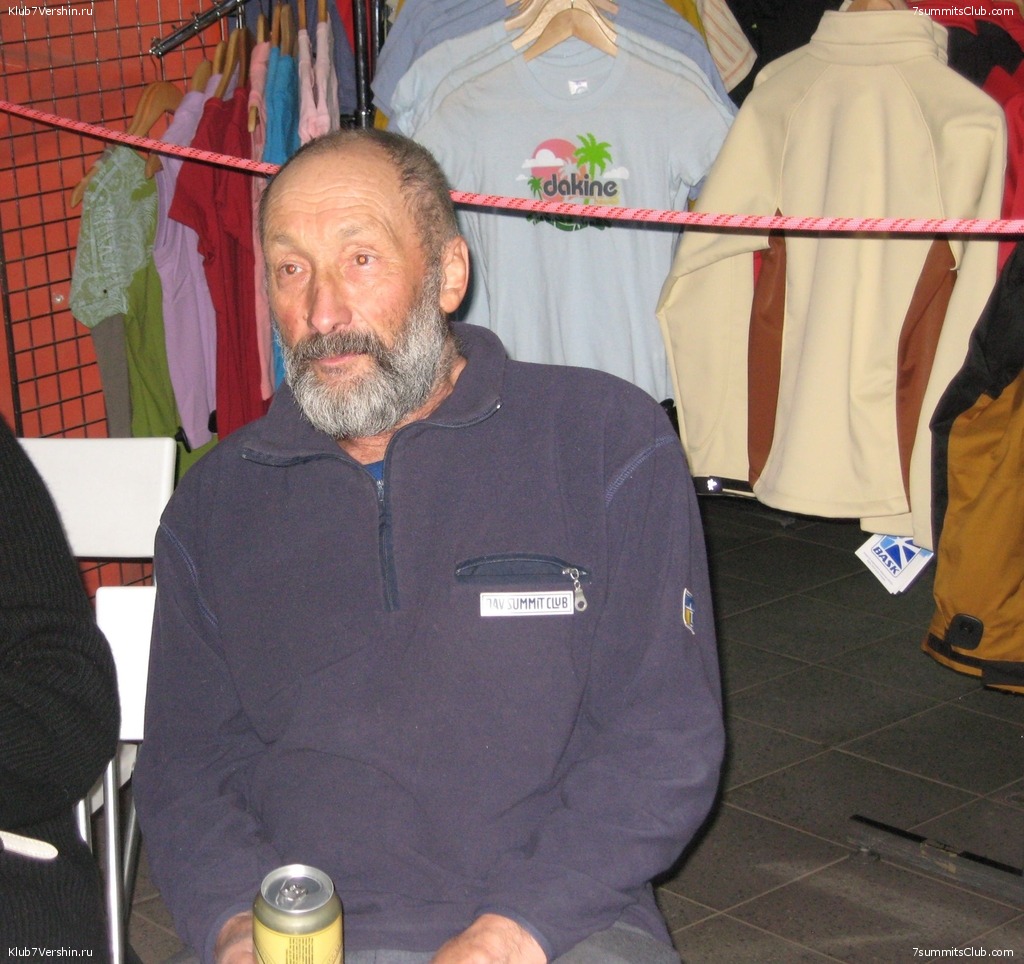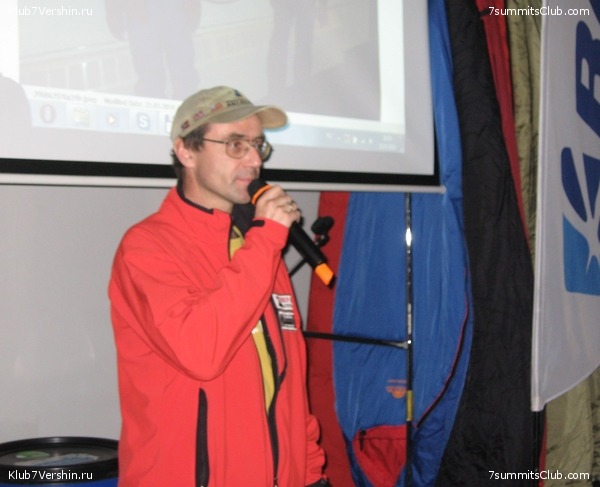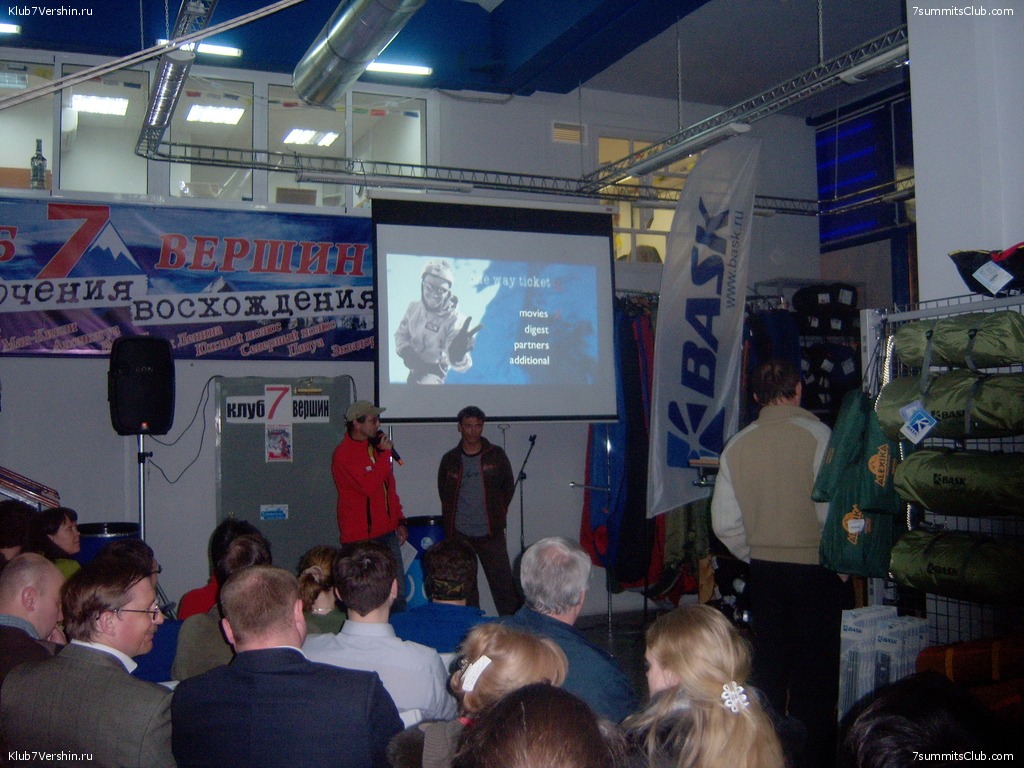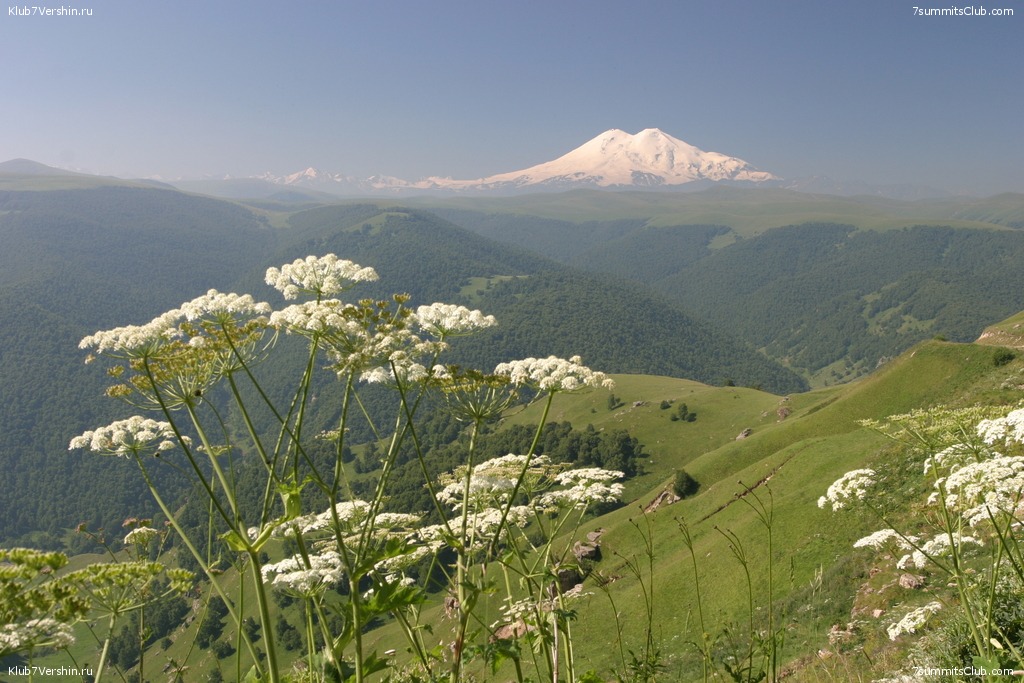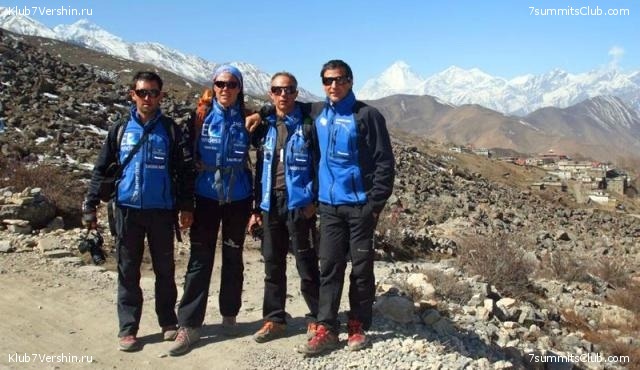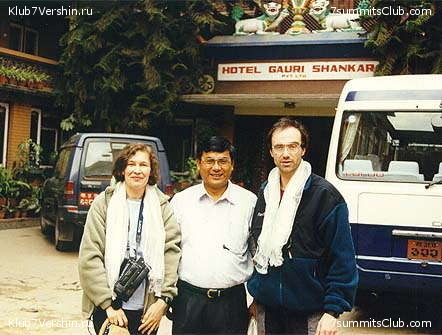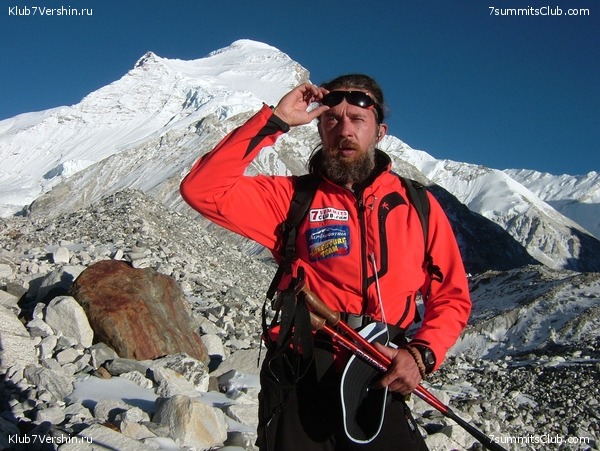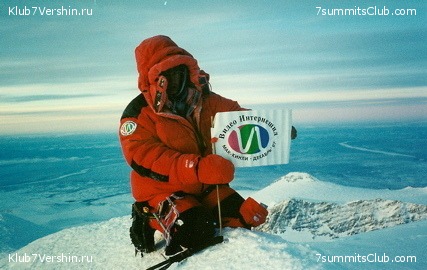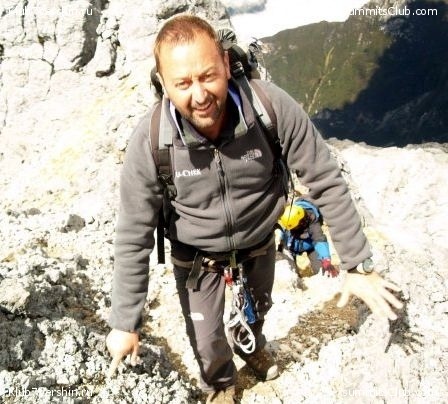7 Summits Club company news
Everest 2010 highlights: Jordan Romero
Everest.
Jordan Romero of Big Bear, Calif., is already an accomplished climber who has reached the tops of some of the world’s highest peaks. At age 10, Jordan and his parents climbed Mount Kilimanjaro in Africa, Mount Kosciusko in Australia, ...
Jordan Romero of Big Bear, Calif., is already an accomplished climber who has reached the tops of some of the world’s highest peaks. At age 10, Jordan and his parents climbed Mount Kilimanjaro in Africa, Mount Kosciusko in Australia, and Mount Elbrus in Europe, Outside Magazine reports. The next year, he was the youngest person ever to climb Aconcagua in South America and Denali in North America. Last year, he climbed Indonesia's Carstensz Pyramid, the highest point in Oceania and the so-called "eighth" summit. Now, along with his father Paul Romero and Paul’s partner, Karen Lundgren, Jordan has his sights set on Everest.
Jordan and Paul Romero
Jordan Romero trains daily to prepare for the extreme hardships of climbing the world’s tallest mountain. No longer in school, he follows an independent study program which allows him to focus on his climbing. The family has two hypoxic tents on loan. His mentors, Romero and Lundgren, are pro adventure racers. But Outside points out that Team Romero seems to operate in a world of all-consuming passions. There are no professional guides on the team, a detail that has experts concerned. If Jordan does complete his record-breaking summit, he'll be the only teen to do so without an experienced Everest climber on his team.
While some point out the importance of Jordan being a role model for active kids, not many Everest climbers support the attempt. Russell Brice is one of Everest's most successful guides. As he told Outside, "I do not see how young people under the age of 18 can gain enough experience about mountaineering or themselves to undertake such a project safely.” Others point out studies on the teenage brain show that it is only 80 percent developed and that to put an emotionally inexperienced child on one of the world’s most dangerous mountains would be irresponsible.
Jordan isn’t letting the doubters stop his efforts. As he told Outside, "I just focus on the goal I set out when I was 9, which is to climb the Seven Summits. I'm just not giving up. Stopping at nothing. I don't let people's doubts bring me down."
FULL ARTICLE IN THE SITE OF OUTSIDE MAGAIZINE
Four or more challenges on Makalu
Makalu.
While the main attention is focused on Annapurna, where women are arguing for the right to be the first on all 14 eightthousanders. Meanwhile, the number of so-called "challenges" in the first place the other giant peak - Makalu. Two teams ...
While the main attention is focused on Annapurna, where women are arguing for the right to be the first on all 14 eightthousanders. Meanwhile, the number of so-called "challenges" in the first place the other giant peak - Makalu. Two teams are planning to make new routes, and the German Luis Stitzinger intends to perform the first ever ski descent from the summit.
41-year-old Stitzinger, in recent years, got a taste for the establishment of outstanding records. He has already made descents on three eight-thousanders, set speed records on the Polish route on Aconcagua, etc. .. His climbing partner is his girtl-friend Alix von Melle, as well a guide, as well an extreme skier. However, on Makalu Luis will skiing alone, too severe would be descent.
Route for ski descent
**********************************************************************
From ExplorersWeb
Americans Chris Warner and Marty Schmidt plan to make waves on a lonelier 8000er: Makalu.
“Marty Schmidt and I are headed to the south side of Makalu, leaving this coming week,” Chris Warner wrote in an email to ExplorersWeb yesterday. “We are hoping to climb a new route to the summit of Makalu SE (7803 meters) and then follow the SE Ridge to the (main) summit.”
Route details
“Our planned route lies between the SW Ridge (opened by Czechs in 1976) and the SE Ridge (Japanese climb in 1970),” expedition website SharedSummits reported. “The route will ascend snow gullies and rock bands, up the 7000 foot face to Makalu SE (7803 meters). Here it joins with the Czech and Japanese routes along the SE ridge, knife-edged and gendarme guarded all the way until the summit.”
“At 8300 meters, a 100 meter rock band blocks the route, making for an extremely technical summit day,” SharedSummits added. The climbers expect to find snow slopes to 60 degrees, ice to 85 degrees and rock sections to 5.7.
Himalaya veterans
Both climbers are highly experienced mountaineers: In addition to new routes on Shivling and winter Ama Dablam, expedition leader Chris Warner has been on 13 expeditions to 8000ers, reaching the summit of Everest (guiding three times), K2, Lhotse, Shisha Pangma (solo south side) and Cho Oyu, plus attempts on Nanga Parbat and Broad Peak.
A regular on Denali and Aconcagua; Marty is a seasoned high mountaineering guide and a four-time Cho Oyu summiteer (including a speed ascent and a ski descent), who also topped-out Kangchenjunga and attempted K2 from both sides.
“Marty Schmidt and I are headed to the south side of Makalu, leaving this coming week,” Chris Warner wrote in an email to ExplorersWeb yesterday. “We are hoping to climb a new route to the summit of Makalu SE (7803 meters) and then follow the SE Ridge to the (main) summit.”
************************************************************************
From Everestnews.com
Will Cross
Will Cross departs shortly for Makalu as part of his Giant Mountain Challenge; a quest to climb six of the highest peaks in the world. All are located in the Himalaya and all are above 8000m. The purpose of this challenge is to demonstrate that one can lead an extraordinary life with diabetes, an incurable condition and a global pandemic. So far, Cross has topped out on Everest, Lhotse and Cho Oyu. He has had diabetes for over thirty years.
Novo Nordisk continues to be the primary corporate partner of this endeavor. Wild Things is the exclusive pack and gear provider. Dermatone is the exclusive sun care protection. HealthiFeet and Adventure Medical Kits have also stepped forward to support the Giant Mountain Challenge.
************************************************************************
March 27, Ukrainian National expedition "Ukraine-Makalu-2010" started from Kiev. The expedition includes 10 climbers, 2 coaches, a doctor. Expedition leader - Valentin Simonenko. The purpose of the expedition - climbing Makalu (8463 m), the fifth summit of the world, by a new route along the South-West Face. This expedition is dedicated to the memory of the famous Ukrainian climber Vladislav Terzyul, who climbed all the Eight-thousanders. He died on the descent is from Makalu, the latest in his list of 14.
The team includes athletes from different regions of the country:
1. Yuri Kruglov - team captain
2. Sergei Pugachev (Gorlovka)
3. Sergei Boublik (Sumy)
4. Maxim Perevalov (Odessa)
5. Vladimir Klebansky (Odessa)
6. Andrew Kiyko (Kharkiv)
7. Alexander Zakolodny (Kharkiv)
8. Paul Kirichek (Kiev)
9. Dmitry Venslavovsky (Vinnitsa)
10. Igor Storozhenko (Donetsk)
Head Coach - Mstislav Gorbenko, the second coach - Michael Zagirnyak, organizer and leader of the expedition, Valentin Simonenko.
Winter Training on Elbrus
Expedition will last 2 months. Upon arrival in Nepal athletes decide to organizational matters, then 8 days walk will reach the base camp .. May 27 athletes plan to return to Ukraine.
The expedition can be monitored at blogging site leader and team captain Yuri Kruglov: kruglov.biz
From the left: Michael Zagirnyak, Yuri Kruglov, Mstislav Gorbenko
Start of the International Everest Expedition of the Seven Summits Club
Everest.
On Sunday leader of the International Everest Expedition Seven Summits Club Alexander Abramov flew to Nepal. Guides and climbers arrive later in early April, and while President of our Club will hold the necessary organizational and ...
On Sunday leader of the International Everest Expedition Seven Summits Club Alexander Abramov flew to Nepal. Guides and climbers arrive later in early April, and while President of our Club will hold the necessary organizational and protocol events that precede the expedition. This year we return to Tibet, which poses the usual problems: obtaining permits, providing transportation and so on. On Monday Alexander arrived in Delhi. It is a temporary stop, as the Kathmandu airport was closed due to bad weather.
Alex Abramov
After a two-year unavailability by political reasons, our club is back to the beloved Northern side of Everest. Although South Face for the year managed to become well loved. Nevertheless, it is on the Tibetan side of Everest where the formation of our company was taken place. Here we gained experience, filled lumps, learned and developed our own standards of service. This experience, we consider invaluable to ensure the safe and most reliable climbing the highest mountain in the world. We have a lot to be proud of. In recent years, nearly all members of our team reached the top, our camp (base and intermediate) are among the best on the slopes of Everest, our tents are heated, which significantly reduces risk of disease, we work with a constant group of Sherpas, who are our close friends, and fully understand all our requirements and rules. In our group there are two physician etc…
Expedition leader, president of the 7 Summits Club Alexander Abramov go to the Everest for the tenth time, to his credit three successful ascents. He will lead his seventh expedition to the highest summit of the world. Deputy leader - Nicholai Cherny his first attempt to climb Mount Everest made in 1982. At the top he was twice. In recent years, Nicholai is acting as the senior coach of national Russian expeditions to the highest mountain in the world: Lhotse Middle, Everest North Face, K2 West Face.
Climbers from Poland take part in our expedition, they are mother and son. Their joint ascent may be a record.
List of members
Daniel MIZERA, Poland (1986)
Krzysztof Flawiusz GINALSLI, Poland (1971)
Malgorzata Bozena PIERZ-PEKALA, Poland (1957)
James de Witt WILDE USA (1970)
Zdravko DEJANOVIKJ, Macedonia (1965)
Elena Gorelik, Russia (1960)
Michail Karisalov, Russia, (1973)
Vadim Nadvodnyuk, Russia (1970)
Mikhail Turovsky, Rossiyal (1961)
Andrew Filkov, Russia (1961)
Steven BERRY, UK (1955)
Guides
Alexander Abramov, Russia (1965) - expedition leader
Noel Hanna, Ireland (1964) guide
Maxim Bogatyrev, Russia (1975) guide
Nickolay Cherny (1938) - Deputy head of the expedition
Sergei Larin, Russia (1959) guide-doctor
Igor Pokhvalin, Ukraine (1957) guide-doctor
Group with permits to the North Col (7000 meters) within the framework of preparations for the ascent to the summit in 2011
Andrew Luss, Russia (1960)
Alexander Perepelkin, Russia (1965)
Svetlana Slavnaya, Russia (1971)
Sergei Dudko, Russia (1964)
Dmitry Krasnov, Russia (1967)
From the farewell party:
Alex Abramov
Nikolai Cherny
Max Bogatyrev (left)
Victor Bobok starts to the North Pole
North Pole.
On Saturday, the leading guide 7 Summits Club Victor Bobok flew from Moscow to Oslo. Further his path will pass through the Arctic archipelago of Svalbard and the station of Barneo to the North Pole. The last 111 km, that is the last ...
On Saturday, the leading guide 7 Summits Club Victor Bobok flew from Moscow to Oslo. Further his path will pass through the Arctic archipelago of Svalbard and the station of Barneo to the North Pole. The last 111 km, that is the last degree, Victor Bobok will lead a team of five tourists. For Victor, if successful, it will be the end of program "Grand Slam" - 7 Summits + 2 Pole on skis. He will be the first in our country who can do it.
Party of the 7 Summits Club was fantastic, thanks Rozov, Alferov .... Everyone!
Elbrus.
Perhaps it was the best party in the history of the 7 Summits Club. First of all, thanks to famous Russian skydiver and basejumper Valery Rozov, which came out three times on the podium. His presence inspired all the other speakers ...
Perhaps it was the best party in the history of the 7 Summits Club. First of all, thanks to famous Russian skydiver and basejumper Valery Rozov, which came out three times on the podium. His presence inspired all the other speakers be concise and accurate time. For the first time, our guides have prepared almost all the reports in the form of slide-films. The technical level is growing. It was so interesting that the guests could not find time to come to the table.
Valery Rozov showed two films and in the conclusion of the evening played the main prize - a certificate for a parachute jump in tendeme with Valery Rozov. This is a real auction. Three of the most deserving on the same evening jumped along with Valery Rozov. See photo. Do not think that we played out of people. Valery Rozov personally agreed with each of the winners of the joint jumping.
In the party we summed up the competition for the best story about your ascent to one of the SEVEN SUMMITS. The Winner Vadim Alferov from Voronezh personally come for the main prize - a certificate on any trip to the 7 Summits Club par 1000 USD!!!
Seeing this, the Everest Expedition 2010, leader Alexander Abramov, guides Nikolai Dmitrievich Cherny, Sergei Larin, Maxim Bogatyrev, Mount Everest, as well as Victor Bobok to the North Pole, and the other guides in Nepal, Tibet and other territories have turned bright and memorable. In June, we all hope to gather for final meeting.
Elbrus traverse from south to north - new way to enjoy it
7 Summits Club is the first adventure company starting to run a totally new Elbrus climb, which includes crossing the Elbrus Col (5300m) from the southern side to northern one. It means you go up from the bustling, noisy and more or less ...
7 Summits Club is the first adventure company starting to run a totally new Elbrus climb, which includes crossing the Elbrus Col (5300m) from the southern side to northern one. It means you go up from the bustling, noisy and more or less civilized Baksan Valley and descend into the calm and quiet wilderness of the northern foothills. From there you will go for several hours in a 4WD vehicle across the high and bare northern pastures offering the superb views of the ranges of West and Central Caucasus.
Elbrus climb with traverse from south to north, 10 days
Special for 7 Summits Club members
Price: 1 290 EUR.
Days 10 / Nights 9
July 24 - August 02;
July 31 - August 09;
With best local guides
If asked about the highest and most dramatic mountains of Europe nine out of ten Europeans will answer “the Alps”. Yet, the grandest and by far the highest mountain chain of Europe (seven summits over 5000m plus Mt.Elbrus with its 5642m) is the Caucasus stretching between the Black and Caspian seas in the continent’s south-eastern corner.
And undoubtedly, Mt. Elbrus, this white double-headed dormant volcano, is the highest, most beautiful and most alluring mountain in Russia.
Last but not least: it will take you just 7-8 hours to get from Moscow to this Seven Summits peak…
The fact that Elbrus is the highest point in Europe suffices for many to go and climb it. Yet, this obvious attraction is not the main one, for Elbrus belongs to a handful of mountains with a very special and irresistible kind of beauty which lies in their shape and setting. Most of them are volcanoes, such as Fujiyama, Ararat and Kilimanjaro, and like all these, this mountain is a world apart. It stands 11km north from the Main Range and exceeds its neighbors in height by 1200-2000m. The views from both the summits are breathtaking: to north it is a rolling carpet of
pastures veiled by the blue haze of distance and on all the other sides the sea of snowy peaks. It is said that through the clear air of autumn you can see both the Black and Caspian seas.
Elbrus from the North
Women climbers in Nepal on world record chase
Women climbers in Nepal on world record chase By Claire Cozens (AFP) KATHMANDU — Two elite mountaineers will next month attempt to climb one of the deadliest Himalayan peaks, Annapurna, as they vie to become the first woman to scale ...
Women climbers in Nepal on world record chase
By Claire Cozens (AFP)
KATHMANDU — Two elite mountaineers will next month attempt to climb one of the deadliest Himalayan peaks, Annapurna, as they vie to become the first woman to scale the world's 14 highest mountains.
South Korea's Oh Eun-Sun and Edurne Pasaban from Spain are among a handful of female climbers competing to be the first female to reach the summit of every mountain over 8,000 metres (26,247 feet).
Italy's Reinhold Messner became the first person to climb all 14 peaks in 1986, but the record has never been equalled by a woman, and Oh and Pasaban are both hoping to make the history books this year.
Oh is the closest to achieving the record with 13 of the 14 peaks -- all of which are in the Himalaya and Karakorum mountain ranges -- already under her belt.
"If I manage to do this I will be incredibly proud, not just for myself but for my country and for Asia," the 43-year-old South Korean told AFP after arriving in the Nepalese capital Kathmandu for the expedition.
"I don't know why no female climber has managed it. I suppose it is down to women's position in the world, which is still not the same as men's."
Oh's chief rival, Pasaban, has two mountains left to climb -- Annapurna and Shisha Pangma in China's Tibet region -- and hopes to attempt both in the brief April-May pre-monsoon season, when weather conditions are favourable.
She had hoped to travel to Tibet first, allowing her to acclimatise before attempting the more difficult Annapurna later in the season.
The 8,091-metre mountain is particularly dangerous because it is both technically difficult and avalanche-prone, and it has a much higher death rate than Everest.
But the Chinese authorities refused her permission to travel there this month, leaving her with no choice but to attempt Annapurna next.
Other competitors for the record are Austria's Gerlinde Kaltenbrunner and Nives Meroi of Italy.
Kaltenbrunner failed in August in a bid to climb the 8,611-metre K2, the world's second highest peak, situated on the Pakistan-China border and regarded as the most difficult of all the eight-thousanders.
She remains at 12 summits, and must still scale Everest on the Nepal-China border, which at 8,848 metres is the world's highest peak. Meroi has conquered 11.
Like Oh, Pasaban has been defeated by Annapurna once before, in 2007 when she and her team turned back about 1,000 metres from the summit in bad weather.
"Annapurna is difficult and dangerous. Some people say it's the most dangerous of them all, and many of my friends have died there. So I go with a little fear," she said in an interview with AFP in Kathmandu.
"If I wasn't trying to do this, I probably wouldn't attempt it. But all my life has been about the eight-thousanders."
Both women will attempt the climb in early April, after spending a month at altitude to acclimatise and train for the task ahead.
Pasaban, 36, who never uses oxygen on her expeditions, admits she has given up much for her sport -- more, perhaps, than her male counterparts.
"The years between 30 and 40 are the best ones for a female climber, but they are also the years that our culture dictates that we should spend having a family," she said.
"A few years ago I faced a lot of family pressure to settle down, and I became quite depressed. But now I am very clear about my goals."
Pasaban admits it will now be hard to beat Oh to the record, although she hints that her South Korean rival's sponsorship deals may have given her an advantage.
Unlike Pasaban, Oh will travel by helicopter to base camp, and have all her ropes set up for her before she arrives.
"Many people speak about competition in the mountains. I think it would have been nice for us to arrive at the top together," said Pasaban.
"But we have decided to climb separately. The mountain will put us in our places."
AFP.
Letter from Ang Tshering: Everest and Cho Oyu news
Everest.
Here is Ang Tshering’s letter in full: Namaste and warm greetings from Nepal. I am delighted to inform you that finally the Spring Expedition Season starting soon and I am pleased to share with you many interesting and positive news ...
Here is Ang Tshering’s letter in full:
Namaste and warm greetings from Nepal.
I am delighted to inform you that finally the Spring Expedition Season starting
soon and I am pleased to share with you many interesting and positive news from
Nepal.
Apa Sherpa,World Record Holder for 19 ascents of Mt.Everest and Climbing Leader
of Eco Everest Expedition is heading for 20th Summit on Mt.Everest this Spring
and Asian Trekking family extends their all support and wishes for the success.
Eco Everest Expedition: Once again this year Asian Trekking is organising the
Eco Everest Expedition (2010). Under the leadership of Dawa Steven Sherpa, Apa
Sherpa (19 times Everest Summiteer: world record holder) as the Climbing Leader
and Nanga Dorje Sherpa as Sirdar. The focus will be on climbing in an eco-sensitive
manner, bringing old garbage, and all human waste produced on the mountain down
to base camp for proper disposal. The expedition will once again be using the
highly successful alternative energy solutions like the parabolic solar cookers
and the SteriPENs for water purification.
This year Dawa Steven and his Eco Everest Expedition team has planned to focus
to collect and bring down previous expedition garbage between the altitudes of
6500 m and above. A team of 10 high altitude Sherpas will be hired to clean up
garbage and debris from such high altitudes. Eco Everest Expedition 2009 team
had brought down nearly 6000 kilos of previous expedition garbage from Mt.
Everest under the Cash for Trash program. This year’s Eco Everest Expedition
targets to bring down 1000 kgs of debris from high altitude above Camp 2 (6500m)
and 6000 kgs of debris from Camp 2 and below.
Since the Spring Season is approaching very closed, The following are the
expedition Teams Confirmed up to today through Asian Trekking:
1. Eco Everest Expedition
2. Kazakh Lhotse Expedition
3. International Everest Expedition 1
4. International Everest Expedition 2
5. International Cho-oyu Expedition
6. International Shishapangma Expedition
7. Chilean Amadablam Expedition
8. Korean Himlung Expedition
9. German Cho-oyu Expedition
Please visit: www.asian-trekking.com for details.
Beat the GLOF Event and Save the Himalaya Khumbu Festival will be held at
Khumjung village on 4 June 2010 instead of 10 – 11 June. The date for this event
has been postponed for the convenience of the guests of 3rd International
Sagarmatha (Mt.Everest) Day Celebration, which will be held on 29 May 2010, to
participate in Beat the GLOF Event and Save the Himalaya Khumbu Festival. The
event will be celebrated with various programs which focus on the mountain
communities, the mountain environment and the impacts of climate change on them.
The event will be supported by Idea,Nepal Tourism Board, Sagarmatha National
Park, and many non government organizations.
2nd New International Airport in Nepal: Ministry of Tourism and Civil Aviation
held a ceremony on March 7, 2010 where an agreement was signed between The
Government of Nepal, Ministry of Tourism and Civil Aviation, and Land Mark
Worldwide Co. Ltd., Korea. The agreement was on the detailed feasibility study
of the second international airport at Dhumberwana, Nijgadh; a town situated in
Bara District, 84 kilometers south-east from Kathmandu. The feasibility study
will have to be completed within 10 months from the date of agreement signed.
Nepal Tourism Year 2011 was officially launched on February 26, 2010 and
preparations have already begun which is sure to make way for improvements in
Nepal’s Tourism. All the political parties of Nepal including the Unified Maoist
Communist Party of Nepal (Maoist) have signed an agreement committing not to
call any bandhs or any such strikes that affect the tourists during the period
of Nepal Tourism Year.
Nepal Mountaineering Association (NMA),TAAN and EOAN have appealed and suggested
to The Government of Nepal to help solve many problems prevailing in the
Nepalese mountain tourism. Among the many requests made following are the main
ones.
A) Since 16 July 2008, the Government of Nepal waived off royalty of the opened
peaks in the Midwestern and Farwestern Nepal for five years (till 16 June 2013)
which shows good sign of positive developments in these region. Similarly it was
requested to reduce the royalty fee of the peaks which is less crowded specially
on the border of Nepal. It has been requested to The Government of Nepal to
manage free permit to climb Mt. Cho-yu for five years from Nepal side.
B) The Tourism Council in the Chairmanship of The Right Honourable Prime
Minister had a meeting where the necessity of operating mountaineering
activities through one door policy was accredited. The meeting was decisive in
implementing this policy in order to create a favourable environment for the
climbers.
C) All associations has requested for permission to make the peaks up to 5999m
high permit free and also to handover the management of peaks that are between
6000 to 6700 m to Nepal Mountaineering Association.
D) It has been suggested to The Government of Nepal to reduce the fees of
communication equipments such as walkie-talkies, satellite telephone, radios,
video cameras, documentary filming, mountain filming etc. and equipments used by
climbing expeditions.
E) 3rd International Sagarmatha(Mt.Everest) Day Celebration will be held on 29
May 2010 with various programs. We expect more than 250 Mt.Everest summiteers,
including renowned climbers like Chris Bonington, Peter Habelar, Apa Sherpa, Min
Bahadur Serchan, Dawa Steven Sherpa, Bill Burke, David Liano, to attend the
program. To honour the Mt. Everest summiteers a request letter has been sent to
The Government of Nepal asking to provide them free visas every time they visit
Nepal. The summiteers will be regarded as the Goodwill Ambassadors of Nepal to
promote Nepalese mountain tourism.
F) Mt. Dhaulagiri Golden Jubilee will be celebrated on May 13, 2010 in Pokhara.
Noted climbers like Kurt Diemberger (first summiteer of Mt. Dhaulagiri), and
Reinhold Messner are the Guests of Honour and many other renowned climbers will
be present to celebrate Mt. Dhaulagiri Golden Jubilee. On this occasion, it is
requested that there should be a 50% concession on royalty for all the climbers
of Mt. Dhaulagiri. Likewise the Summiteers of Mt Dhaulagiri should be provided
free visas from 2010 to 2011.
Also please visit the following links:
http://www.climate4life.org
http://www.theuiaa.org/news_219_Letter-from-Ang-Tshering-Sherpa-president-Nepal-Mountaineering-Association
http://www.guardian.co.uk/environment/video/2009/dec/10/copenhagen-sherpa-himalayas
http://www.lindamcmillan.com/picture-gallery http://www.lindamcmillan.com/picture-gallery
http://www.adventuretravelnews.com/updates-from-the-nepal-mountaineering-association
http://www.usaid.gov/press/frontlines/fl_feb10/p09_climate100221.html
http://www.agrobiodiversityplatform.org/blog/?p=2870
http://www.theuiaa.org/act_mountain_protection.html
http://www.everestnews.com/stories2010/everest201001042010.htm
http://www.americanalpineclub.org/exitstrategies
http://www.festivalalpinismu.cz/fotogalerie
http://www.festivalalpinismu.cz/program/2-program-patek
http://www.festivalalpinismu.cz/program/48-nedele22
Finally I would like to express my sincere thanks and gratitude to the Prime
Minister and The Government of Nepal for nominating me as the member of National
Tourism Council and my son Dawa Steven Sherpa as the member of Climate Change
Council to the Prime Minister.
I am also thankful to the International Olympic Committee and Mr. Jacques Rogge,
president of The International Olympic Committee for presenting Dawa Steven
Sherpa the “International Olympic Committee Award for Sports and Environment.”
With kind regards,
Ang Tshering Sherpa
Ten years ago
Expedition "Russia on the tops of the world" at the summit of Aconcagua
Aconcagua.
7th of March a group of mountaineers from the expedition "Russia on the tops of the world" at 1 p.m. local time, reached the summit of Aconcagua. According a preliminary information, the highest point was reached by 20 climbers. In ...
7th of March a group of mountaineers from the expedition "Russia on the tops of the world" at 1 p.m. local time, reached the summit of Aconcagua. According a preliminary information, the highest point was reached by 20 climbers. In the evening all climbers successfully descended to the camp Colera. Now, in the morning, the expedition began descent to the base camp at Plaza de Mulos. There climbers will celebrate two holidays at once: summit and 8 March.
…
“Russia at the tops of the world" expedition started at 24th of February, with logistic support of 7 Summits Club. The team consists of 25 climbers from North Ossetia plus a guide of 7 Summits Club Lubov Ivanova.
The idea of this campaign was born almost two years ago, its initiator famous Russia climber, chairman of the Federation of North Ossetia, Kazbek Khamitsaev. In 2008, the project began, first summit to climb was Mount Kilimanjaro. The next goal is South American highest peak - Aconcagua.
The 2010 is also scheduled to climb the summit of Mount Kosciuszko - the highest point of Australia. In 2011 Russia climbers going up on Mount McKinley in North America, in 2012 - on Mount Vinson in Antarctica. Next year Khamitsaev will climb North Face Mount Everest by a new route.
Finally, during the 2014 Olympics the team plans to climb Mount Elbrus with Olympic flame. From this climb it will be organized a teleconference with the Sochi.
The project is supported by the Government of the Republic of North Ossetia-Alania, Mountaineering Federation of Russia, Mountaineering Federation of the Republic of North Ossetia-Alania, the Alpine Club of the Republic of North Ossetia-Alania "Kazbek".
Project Partner - OAO MegaFon
Groups of “7 Summits Club” on Kilimanjaro, one after another ….
Kilimanjaro.
At the end of last year, in chain restaurants Tavern "Taras Bulba", the leadership held a contest of professional skill. Two winners, boy and girl, have been identified – Janna Oskolkova and Dmitry Khamidov. The main prize of the ...
At the end of last year, in chain restaurants Tavern "Taras Bulba", the leadership held a contest of professional skill. Two winners, boy and girl, have been identified – Janna Oskolkova and Dmitry Khamidov. The main prize of the contest was a safari on the African continent and the ascent of one of the one of most remarkable mountain of the world - Kilimanjaro. The winners went to Africa together with the company's founder, an experienced mountaineer, a member of the 7 Summits Club, Yuri Beloyvan.
February 28. Yuri Beloyvan and Dmitri Khamidov climbed Mount Kilimanjaro to the peak of Uhuru .. Janna Oskolkova, unfortunately, has not reached the main summit - only Gillmans Point, which is also not bad for novice.
7 Summits Club congratulates Yuri Beloyvan and the staff of Tavern Taras Bulba with another achievement!
By the way, Yuri Beloyvan (photo below) has to its credit 5 of 7 Summits project “7 Summits of the World”.
Tavern "Taras Bulba" is the perfect place for meetings, which we visit with pleasure.They propose home Ukrainian cuisine and very reasonable prices.
A few days before on the summit of Uhuru peak was climbed by a group of our Club: Sergei Zheltov, Anatoly Kalyaev, Igor Kalyaev, Sergey Protsenko, Sergei Skachek .. Tomorrow we look forward to their return to Moscow. After Kilimanjaro, this group spent 4 days in the national parks of Tanzania ..
The next group led by Victor Bobok goes to the top after them.
Editor NG Traveller Alexander Zheleznyak also recently returned from Africa, where we helped him in organizing the trip to the National Parks and climb of the Meru Peak. We are waiting for his excellent photographs in the new issue of the journal.
-
The team “Russia at the tops of the world" with Luba to finish acclimatization
Aconcagua.
According the information from Luba Ivanova a guide of Club "7 Summits", the first day of spring, the team “Russia at the tops of the world" has reached Plaza Canada (4850 m) . Here they were met by huge storm. Earlier, a few days in ...
According the information from Luba Ivanova a guide of Club "7 Summits", the first day of spring, the team “Russia at the tops of the world" has reached Plaza Canada (4850 m) . Here they were met by huge storm. Earlier, a few days in a row district Aconcagua was badly shaken, the epicenter of the catastrophic Chilean earthquake was located only 200 km. Officially, in region of the highest peaks in South America, the earthquake had a force of 7-8 points.
March, 2 the group started to climb Nido de Condores (5350 m), where they will overnight for acclimatization. By this the stage of acclimatization will be completed and begin preparations for the summit bid.
“Russia at the tops of the world" expedition started at 24th of February, with logistic support of 7 Summits Club. The team consists of 25 climbers from North Ossetia plus a guide of 7 Summits Club Lubov Ivanova.
The idea of this campaign was born almost two years ago, its initiator famous Russia climber, chairman of the Federation of North Ossetia, Kazbek Khamitsaev. In 2008, the project began, first summit to climb was Mount Kilimanjaro. The next goal is South American highest peak - Aconcagua.
The 2010 is also scheduled to climb the summit of Mount Kosciuszko - the highest point of Australia. In 2011 Russia climbers going up on Mount McKinley in North America, in 2012 - on Mount Vinson in Antarctica. Next year Khamitsaev will climb North Face Mount Everest by a new route.
Finally, during the 2014 Olympics the team plans to climb Mount Elbrus with Olympic flame. From this climb it will be organized a teleconference with the Sochi.
The project is supported by the Government of the Republic of North Ossetia-Alania, Mountaineering Federation of Russia, Mountaineering Federation of the Republic of North Ossetia-Alania, the Alpine Club of the Republic of North Ossetia-Alania "Kazbek".
Project Partner - OAO MegaFon
Sochi 2014 Ambassadors are a select group of sporting and cultural icons who help to promote Russia's first Winter Games and spread the Olympic values worldwide.
Kazbek Khamitsaev. "Climbers know that when conquering the summit, you suddenly acquire a second wind. We wish the Sochi Games organizers to always move forward - from peak to peak- and ultimately, to conquer the main summit and hold the best Olympic and Paralympic Games."
Expedition chief Kazbek Khamitsaev is very experienced climber. He was the leader of three expeditions to Mount Everest, twice climbed the highest peak of the world, making professional video shoot at the top. He also led four expeditions to Pamir and Tien Shan mountains, climbing the five 7,000m peaks: Lenin Peak (7134m), Korzhenevskaya Peak (7105m), Communism Peak, the highest peak of the USSR (7495m), Khan Tengri (7010m), and Pobeda Peak (7439m). So Kazbek ”Snow Leopard.”
Start of season; Edurne Pasaban hope to become the first woman on 14 highest peaks
Spanish mountaineer Edurne Pasaban said she hoped to become the first woman to scale the world’s 14 highest peaks by conquering the Shisha Pangma and Annapurna mountains this spring. “I leave on March 4. I still have ...
Spanish mountaineer Edurne Pasaban said she hoped to become the first woman to scale the world’s 14 highest peaks by conquering the Shisha Pangma and Annapurna mountains this spring. “I leave on March 4. I still have Shisha Pangma and Annapurna to do and I aim to try in the spring. I am going first to Shisha and then to Annapurna,” she told the Spanish newspaper ABC published Tuesday.
With Juanito Oirazabal - his climbing father
Last October, bad weather forced her to abandon an attempt to climb the 8,027-metre Shisha Pangma, situated in China’s Tibet region. That would have been her 13th summit of more than 8,000 metres, and left only Annapurna to conquer to become the first woman to scale all of the world’s 14 ‘eight-thousanders.’
Pasaban’s chief rival, South Korea’s Oh Eun-Sun, failed in October in a bid to scale the 8,091-metre Himalayan peak Annapurna, also due to weather conditions. That would have been the 14th and final summit in Oh Eun-Sun’s record attempt. “The Korean only has Annapurna. We will see each other there if we manage to scale Shisha Pangma quickly,” said Pasaban, 36. Weather conditions are considered ideal for climbing in the Himalayas in the April-May pre-monsoon season.
Other competitors for the record are Austria’s Gerlinde Kaltenbrunner and Nives Meroi of Italy. Kaltenbrunner failed in August in a bid to climb the 8,611-metre K2, the world’s second highest peak situated on the Pakistan-China border and regarded as the most difficult and dangerous of the 14 ‘eight-thousanders’. She remains at 12 summits, and must still scale Everest on the Nepal-China border, which at 8,848 metres is the world highest peak. Meroi has conquered 11. Italy’s Reinhold Messner became the first man to climb all 14 summits in 1986. The second to achieve the feat was the late Polish legend Jerzy Kukuczka, with many of his ascents on new routes or in winter. The 14 mountains are all located in the Himalayan and Karakoram ranges in Asia. afp
All Baskonia for Edurne, training with famous cyclist Roberto Heras
Winter Denali: Christine Feret off on the first female attempt with Artur Testov
Feb 24. The expedition kicked off yesterday from Alaska's Talkeetna: Christine Feret and Artur Testov were dropped on Kahiltna Glacier at 6,800 feet. “We will slowly go up, pulling all our gear and food (250 pounds) with sleds, ...
Feb 24. The expedition kicked off yesterday from Alaska's Talkeetna: Christine Feret and Artur Testov were dropped on Kahiltna Glacier at 6,800 feet. “We will slowly go up, pulling all our gear and food (250 pounds) with sleds, “Christine told ExplorersWeb before departure. “All going well, it should take a minimum of four weeks.”
No tents for McKinley’s wild season
In winter, there is no BC or ranger service on the peak. The two climbers are not bringing tents. “Instead, we will go each day as long as we can and dig snow caves for the rest of the day,” Christine told ExWeb. “It takes about 4-5 hours to make a good one – days will be long!”
“We are still taking a small tubular tent for safety, but intend to use it only in case of emergency,” Christine added.
“We are bringing a couple of sharp heavy steel shovels for chopping harder ice,” Feret explained. “We did it last May at 17,500 and it worked fine. We are carrying a load of 270 pounds that we will split between our packs and sleds.”
Ladder for crevasses
“Artur is of course taking his ladder for crevasses as well! He will be first and in case he falls, the ladder should hold him before reaching too deep down in the crevasse – which is essential for a quick self-rescue and to prevent frostbite: At -40ºC, we don't have a couple of hours to get out of a crevasse like in summer time.”
“We hope we will not have feet and feet of snow to push until Windy Corner. There can be so much snow until there in the winter. We will bring the sleds to 14,200 then will use a drag bag at the end of our rope for the Head Wall.”
Ready to go
Already familiar with the terrain since she climbed Denali twice last spring, Christine looks forward to get close up and personal with the peak off season: “This should be a fun wild adventure!!! I am the first woman to step foot on McKinley in the winter so it sure adds a little extra spice to the ordeal but either way, awesome mountain in extreme environment is exciting enough for me!!!”
---------------------------------------------------------------------------------------------
http://www.artur-testov-climbalaska.com/index.html
About Christine Feret
Christine was brought up in France and lives in Alaska with Artur along the Knik River, few miles from the Knik Glacier. An avid lover of Nature, Life and adventures, she has spent years traveling in remote parts of India, Nepal, Sri Lanka, Philippines living her dreams and pushing her limits. She has a wonderful daughter Manon whom she dedicates this attempt to... "Put fears aside, and live your dream..."
About Artur
He started specializing in winter climbing in 1988 and first set foot on the Alaskan Mt McKinley in 1994. He has since climbed it over 10 times, using different routes and at different times of the year.
Artur was born in the small city of Riazan in Russia on August 4th, 1965. He started training in mountaineering as a young teen in the then USSR and dedicated his youth to this discipline. When not climbing, he specialized in the construction of high buildings such as church towers.
Artur is a true passionate and purist. He climbs for the love of the mountain and the beauty of his discipline and not for any glory. He lives in the wilderness in Alaska along the Knik River and enjoys a very particular and amazing relationship with Nature.
Artur says he feels alive when he is out there. When asked why he doesn't try his winter climbs in March (still winter in Alaska), his answer is always the same : What's the point? If I'm gonna climb in winter, I'm gonna do it when it's really winter, with the cold and the short days. The challenge is at least as much fun as the success!"
In January 1998, Artur and his partner Ananich made international news when they successfully summited McKinley. They are the only climbers to ever summit in the dead of winter, January being the darkest and coldest month in Alaska. They used the classic route, called the West Buttress.
The following winter, he and Alaskan climber Trigger attempted the ascent of the Wichersham Wall but had to turn around after 3 weeks of grueling cold and blizzard.
Few years before, Artur successfully crossed on foot the 900 kms KaraKum Desert in Turkmenistan in August without any life support. He and his partner are to this day the only ones to succeed crossing this desert in an unsupported expedition.
On December 21st 2007, Artur attempted to climb solo the never summitted in the winter Wickersham Wall on the North Face of Mt McKinley. Also known as the "Wall of Darkness", it is one of the biggest ice slope in the world with a vertical difference of almost 15,000 feet. It does not receive any direct sunlight, the temperatures are almost constantly in the 60s to 70s below (-50 to -60 Celsius). The very common blizzards bring the windchill factor to well over 100 below (-75 Celsius).
-------------------------------------------------------------------------------------------
Arthur Tests (second from the left) came to Alaska for the first time in 1994, within a team of Seven Summits, the first time collected by Alexander Abramov (first from the left).
Deep Exploration in a Muslim country
Alexander Abramov and Ludmila Korobeshko rented a jeep to try for a week to get all of Morocco from Casablanca to the Sahara. The purpose of this expedition is to understand why this country is so popular in the west as the direction of ...
Alexander Abramov and Ludmila Korobeshko rented a jeep to try for a week to get all of Morocco from Casablanca to the Sahara. The purpose of this expedition is to understand why this country is so popular in the west as the direction of adventure tourism. And on this basis to draw practical conclusions.
Spend an unforgettable night in Casablanca, and looking at the Mosque of Hassan II in height of 200 meters (it is higher than the pyramids in Egypt), they went to Marrakech and from there to the village of Imlil - in the heart of the Atlas Mountains.
On the way travelers hit the great conditions of road and kindness of the local population.
Having completed a three-day trekking, Alexander and Lyudmila climbed the highest peak of the Atlas Mountains and throughout North Africa - Toubkal (4167 m).
Beautiful mountains ! Excellent shelter is located at an altitude of 3200 meters, with a hot shower.
Yesterday, they went down to Marrakesh. At 5 am the next day they started toward the Sahara, to travel by camel to the dunes and spend the night in a Berber tent.
Palestinian mother scales Antarctica's highest peak
Vinson.
Suzanne sets a towering example for Arab women. Suzanne Al Houby, the first Arab woman to scale Mount Vinson, Antarctica's highest mountain, is the vice-president of the Dubai Bone and Joint Centre. She braved subzero temperatures, fierce ...
-
Suzanne sets a towering example for Arab women. Suzanne Al Houby, the first Arab woman to scale Mount Vinson, Antarctica's highest mountain, is the vice-president of the Dubai Bone and Joint Centre. She braved subzero temperatures, fierce winds and frostbite to become the first Arab woman to reach the summit of the highest mountain in Antarctica, but Suzanne Al Houby is no stranger to adventure.
-
The Palestinian mother of two, who lives in Dubai, is now the first Arab woman to scale the highest mountains in four continents. Suzanne has also climbed Mount Kilimanjaro in Africa, Mount Elbrus in Europe, Mont Blanc in the Alps in western Europe, and Mount Aconcagua in South America.
-
Suzanne (right) sets a towering example for Arab women
-
Suzanne said: "Although this is neither my first nor my biggest mountain, its location was in the harshest and the most isolated continent on Earth. Climbing to the top gave me an overwhelming feeling of pride because only 700 climbers have attempted to reach the top of Mount Vinson."
-
Suzanne, who holds a day job as the vice-president of the Dubai Bone and Joint Centre, set out on her expedition on January 8 and took 18 days to scale Mount Vinson and return to base.
-
Vinson is Antarctica's highest mountain at 4,898 metres. It is 20 kilometres long and 13 kilometres wide in the Sentinel Range in the Ellsworth Mountains, and was discovered in 1958 by a US navy aircraft.
-
"An assuring voice was echoing in my head while I was climbing. It kept telling me that I was strong, that I had to keep going and not doubt myself. I had to constantly remind myself that there was no such thing as quitting."
-
The day Suzanne reached the summit was memorable, as the temperature was well below minus 37 degrees. One hour before the expedition reached the peak, strong winds brought the temperature further down to minus 50. Yet she continued to climb.
-
Harsh weather
-
"I could only enjoy the summit for less than five minutes because of the fierce wind. By simply being able to endure the extreme weather conditions without losing any of my fingers and toes due to frost bite is in itself a difficult goal to achieve."
-
Suzanne's success in scaling towering mountains could be credited to her ability to isolate herself from the worries of the mundane city life, and merely focus her energy on purifying and cleansing her soul. While some people tend to immerse themselves in their jobs, Suzanne always makes time for her adventures no matter how busy she may be.
-
She achieves this through efficient time management.
-
"God created the wilderness for us to appreciate His works, and Antarctica is the wildest place on Earth. It does not have any inhabitants and is also one of the most isolated. The endlessly white, bitterly cold, white nights on the continent redefined [my definition of] wilderness," Suzanne said.
-
In order to endure the harsh weather while climbing, Suzanne had to harness her mental strength, which was as important as her physical strength. Her success was also achieved by keeping her head clear of distractions as well as focusing on her objectives one step at a time.
-
"The only way you can discover your full potential is by going to a place where you cannot take your comfort zone with you.
-
It is amazing how much, as humans, we can endure. I hope that other Arab women will get encouraged to do such climbs, because all you need is to believe in yourself and your potential," Suzanne said.
-
-
-
Suzanne climbed Elbrus in 2005 with a team of famous Christine Boskoff
-
gulfnews.com
Nine climbers reached the summit of Uhuru Peak by the Machame route!
This morning a group of Belarusian climbers of Club Seven Summits reached the highest point of the massive Kilimanjaro - Uhuru Peak (5895m). February, 19 early in the morning on the summit were: 1. Antonovskaya Ludmila 2. Varanitsa ...
- This morning a group of Belarusian climbers of Club Seven Summits reached the highest point of the massive Kilimanjaro - Uhuru Peak (5895m).
- February, 19 early in the morning on the summit were:
- 1. Antonovskaya Ludmila
- 2. Varanitsa Alexander
- 3. Klimovich Sergey
- 4. Yarunicheva Alena
- 5. Alexander Gordeev
- 6. Natalia Gordeeva
- 7. Gavrilenya Alex
- 8. Mikhail Korotkov
- 9. Konstantin Korotkov
- Now the whole group went down to Mweka Camp at 3100m, and is celebrating its success.
- We warmly congratulate our friends !
Josu Feijoo climbed Aconcagua controlling their diabetes and finished his 7 summits challenge
Aconcagua.
The mountaineer form Vitoria (Basque, Spain) Josu Feijoo and teammate Jon Goikoetxea from a team of athletes with diabetes have managed to climb Mount Aconcagua - the highest mountain in South America. Josu has been climbed all times ...
- The mountaineer form Vitoria (Basque, Spain) Josu Feijoo and teammate Jon Goikoetxea from a team of athletes with diabetes have managed to climb Mount Aconcagua - the highest mountain in South America. Josu has been climbed all times controlling disease through 'Emminens Connect', a telemedicine system created by Roche 'Emminens Connect', which sent the message levels for mobile physicians in Spain. Josu became the third of diabetics to climb the highest peaks on all continents.
- Completion of this program a long time was postponed due of Fejoo's participation in the space program by Richard Branson. Last year he passed all tests in the U.S. astronaut training centers, but the flight is delayed. In April 2009, Josu chose the time and went to the "green continent", made an ascent of Mount Kosciuszko and Carstensz. On Aconcagua, he took with him another two diabetic climbers from other parts of Spain …
High on the Carstensz
- In 2006, Josu Feijoo climbed on the north side Everest and was on the summit on May 18, as the first diabetic in history. Two others famous diabetic Austrian Geri Winkler and American Will Cross climbed from the south. The Austrian, who came to the foot of the mountain on bike from the level of the Dead Sea (the lowest point of land on Earth) was on the top on May 20, and an American (father of six children), climbed Mount Everest on May 22. With this ascent Cross completed a program of "Seven Summits", Winkler did it two years later.
- Become the first astronaut among people living with diabetes - this is now the main objective of Josu. Basque is going to fly within a team of Virgin Galactic, the private space tourism project, which implements the famous billionaire Richard Branson. During the flight, he intends to use insulin, a new generation, which has a longer effect.
- With his spaceship
- Now Feyo is 43 and 19 years ago he was diagnosed with diabetes type-1. He never stops mountain climbing, but only in recent years, he managed to reach a new level. He managed to establish permanent cooperation with sponsors and become almost a professional traveler. In addition to the "seven summits" on account Fahey dozens difficult climb at home and in the Alps, independent trips to the North and South Poles, and much more. Josu married, wife's name is Tanya and their daughter grows up.
- "I have learnt how to exploit it, but not just for Josu Feijoo, more than anything I’ve done it for the whole group"
- www.irrika.net
- Published in : Enthusiast Written by Lorea Arakistain on 2009-04-06
- “Where there’s a will, there’s a way”. And as far as this mountaineer is concerned, there’s no doubt that there is. He will shortly be packing away his mountaineering boots and, wrapped up in an astronaut’s suit, will be heading into Space. If everything goes according to plan, he will be the very first diabetic astronaut. So far, he is the first diabetic to have reached the two Poles and Mount Everest.
- You’re going into space!
- When I was five and used to write to the Three Kings of the Orient, I used to put: “I want to be an astronaut”. And yes, I can say that Melchior, Caspar and Balthasar, and Santa Claus or Olentzero do exist. Because in a few months’ time my dream is going to come true and I’m going to be so proud to be able to take my country’s flag, the ikurriña [the red, white and green Basque flag], into space.
- Aren’t the eight thousand metre peaks close enough to the sky?
- Mountaineering is a way of life, I’m going to be a mountaineer all my life. Life goes on, you meet that challenge, you do the North and South Poles, you scale 8,000 metre peaks, Mount Everest... But age, the social commitments you have with respect to research… cause you to close some circles and open up others. And if you combine the fact of closing certain circles with your dream of becoming an astronaut, you get the right chemical combination to make this little reality come true.
- How did this proposal come about?
- 5 years ago when I was surfing the Internet, I saw that an American company was designing a spacecraft. I started sending e-mails to support the venture. And then to my surprise they sent me an e-mail thanking me for my encouragement and asking what they could do for me. I replied immediately saying: “I want to be an astronaut.” And they said: “You could try, only you’ll have to pay for the fuel.” And that was it.
- And who is going to pay for the fuel?
- A trip into space is terribly expensive, it costs thousands of millions. I spoke to the laboratories, to the companies that had been sponsoring my climbing projects. I have the support of some Basque companies that would love to see the ikurriña in Space, thanks to a few Basque politicians who spoke to them. These companies are not after the marketing, but are doing it to support the chronically ill. The impact that my trip is going to make as a chronically ill person is considerable. Nothing is going to be impossible any more. It will be complicated, but not impossible.
You’re going to conduct an experiment, and it won’t be the first one, will it?- We’re going to experiment with a new kind of insulin in which the hormone has been slowed down to a maximum. It isn’t about the hope of a cure but about improving quality of life. We’re also going to try out a new device for measuring glucose in the blood; it’s more modern and has a telemedicine system.
- An adventurer, How and since when?
- In the Basque Country being a mountaineer is easier than unwrapping a lollipop. But I don’t regard myself as an adventurer, although I do get itchy feet. I would never have thought that because I scale mountains that there would be companies that would want to acquire my image rights and that I could live off that. Although I’m in no doubt that this will soon be coming to an end.
- A diabetic can’t be a fire fighter but can be a mountaineer or go into space.
- There are people who have climbed with me and who cannot be forest rangers. It’s today’s Spanish legislation that imposes these barriers on us. I know that when many school kids find out I’ve reached the summit of Mount Everest, they say: “Why not?… I can do the same sport”.
- How has diabetes changed your life?
- It has transformed it. It started when I was 23. With your first wages you like having a night out, but all of a sudden an endocrinology specialist appears and tells you to forget everything you used to do and that you have to change all your habits. I was depressed for nine months; I had a really bad time. But then I realised that I didn’t want to live for diabetes.
- You say you are finding out how to exploit your diabetes.
- I can’t hide the fact that there are companies out there. I think I have learnt how to exploit it, but not just for Josu Feijoo, more than anything I’ve done it for the whole group.
The next success on Aconcagua
Aconcagua.
Today we received a message from our guide Victor Bobok from Aconcagua. Yesterday, 16 February, the group climbed the summit. The ascent was complicated by the fact that was started from the camp "Nido de Condores”. Everybody is very ...
- Today we received a message from our guide Victor Bobok from Aconcagua. Yesterday, 16 February, the group climbed the summit. The ascent was complicated by the fact that was started from the camp "Nido de Condores”.
- Everybody is very tired, but generally feels good.
- Here is a list of those who stood on the highest peak of South America:
- Victor Bobok - guide
- Oleg Vorobyev
- Valery Kurennoy
- Andrew Levin
- Anton Ostapenko
- Andrew Podolyan
- Tatiana Stukalova
- Alexei Sushkov
- Stanislav Shitkov
- Congratulations to all !
Campanini Foundation saves lives
Aconcagua.
Federico Campanini lost his life on Aconcagua in January 2009. Created in memory of Federico, The “El Fede” Campanini Foundation is dedicated to providing information, guidance, training and financial assistance to support ...
Federico Campanini lost his life on Aconcagua in January 2009. Created in memory of Federico, The “El Fede” Campanini Foundation is dedicated to providing information, guidance, training and financial assistance to support ongoing efforts to improve mountain rescue on Aconcagua and in other commercial climbing areas.
- elfede.org
- Federico, or as he was fondly known, “El Fede,” Campanini was an Argentine climber and mountain guide whose passion for the mountains and for life was contagious. Federico found solace and purpose in the mountains and he loved sharing his knowledge and love of them with everyone who knew him; the lives of his family, friends, clients, and many others were changed forever by his presence.
- Mission Statement:
- The endeavor will not be easy, but it is possible through the support from those who share Federico’s love for the mountains.
-
Text by Amber Christiansen, widow of Federico
- Off to move mountains…it moved me
- I left for Aconcagua on Jan. 13 with the head park ranger of Aconcagua. On January 15 we arrived at Plaza de Mulas base camp (14,000 ft) and we stayed there for 4 days in order to acclimatize. It was quite an amazing time in which I talked to many people who participated in the rescue efforts of Fede and the Italians (more than 60 in total participated in some form, whether by melting snow or trying to save Fede's life). All were very moved and affected by the loss of Fede's life and I think my presence was a positive one, a reminder that something positive can come from a tragedy. We talked a lot and discussed ideas for the future and everyone learned how to use the equipment. Many, both locals and foreigners expressed interests to support rescue efforts. In addition, National Geographic was doing a documentary on Aconcagua and its search and rescue system. They interviewed me; hopefully this will also generate international interest, we shall see...
- In four days time, there were four separate rescue efforts. In each one, the equipment that the foundation donated was used.
- On January 19 we installed the first rescue cache at Nido de Condores (17,700 ft). That night, a Czech climber suffered from pulmonary edema and we used the oxygen from the cache.
- On January 20 we left at 7a.m. from Nido de Condores to Independencia (21,000ft.) Another group went to La Canaleta (22,000ft). After we installed the cache at Independencia we spent an hour and a half resting and talking about life. One hour later we received news that a woman collapsed at the summit of Aconcagua. The same group of individuals that had installed the rescue cache at La Canaleta helped the woman by using a litter and oxygen that they had put in the cache just one hour before. We had already started descending when we heard the call for help. We waited at Camp Berlin (about 19,000ft) for three hours to help them with the descent of the woman in the litter. By the time they arrived it was dark and ten of us (me being the only woman) took turns carrying the sled. It was a crazy time, and I kept focusing on the woman's eyes, to make sure she didn't close them. She was French and didn't speak any Spanish and very little English. She was scared and I tried to soothe her fears. When we got to Nido she was put on oxygen and then they descended her to Plaza de Mulas in a litter where she was evacuated the following day in a helicopter.
- My goal was to save one person's life with the rescue equipment and this occurred just one hour after they were installed.
- The next day a woman fell while descending and broke her leg. Again the litter was used as well as a trauma kit for stabilizing the break. The first aid kits that were stored at Nido de Condores were never stored, they were used every day, one incident after another.
- I cannot explain life, or the events that occur, or why, when Fede was struggling for his life this equipment wasn't there, but it is there now, it is there now.
- After this experience, and being there, and seeing the summit, I decided I needed to summit, to see what happened.
- On January 23 at 12:00p.m. I summited Aconcagua. It was a struggle, I felt nauseas, but I understood the efforts of so many individuals who tried to save Fede.
- Aconcagua is a community of people that share a love for the mountains, they take care of each other. Unfortunately they don't have the support of a government which should provide more resources.
- So, on January 25 I began my return to the entrance to Aconcagua Provincial park. I decided I wanted to walk, even though I was offered a ride in the helicopter. It was difficult to leave, this community that works together and saw me as a hero. I am not a hero, but I did love Fede and I do also, love the mountains. I have learned more about the accident, and it continues to break my heart, but life must continue, it must.
- T o understand death is to understand life.
- There is still a lot of work to do but something is moving.
- Please help support our cause to improve rescue efforts by sharing your thoughts and ideas in the forum or donating to our funds for rescue and training efforts.
- Please contact amber@elfede.org for more information or questions on how to donate.
Chad Kellogg: Solo New Route on Aconcagua South Face…
Aconcagua.
The line of Medicine Buddha (VI WI4 M4, 6,500'/1,980m of new ground) on the 3,000-meter south face of Aconcagua. Chad Kellogg joined the Messner Route and then the upper Argentinean Variation above the enormous serac band. American ...
The line of Medicine Buddha (VI WI4 M4, 6,500'/1,980m of new ground) on the 3,000-meter south face of Aconcagua. Chad Kellogg joined the Messner Route and then the upper Argentinean Variation above the enormous serac band.
American Chad Kellogg has soloed a dangerous new line on the famed south face of Aconcagua (6,962 m).
Red line - route of Kellog, blue - exit variant of Messner
Kellogg traveled to Argentina with Rory Stark, aiming to acclimatize on the normal route on Aconcagua's north side and then attempt a line on the south face. Kellogg also wanted to try a one-day round trip on the normal route.
As planned, Kellogg summited via the normal route on December 17, but Stark was stricken with pneumonia high on the mountain. With the help of some fellow Americans, they descended all the way to base camp that day, but Stark remained severely ill and had to be helicoptered to town for treatment; he eventually returned to his home in Alaska and recovered.
On December 21, after repacking their gear and laying plans for a solo attempt on the south face, Kellogg hiked in to the base. A snowy winter and recent poor weather had plastered the face with ice and filled in crevasses, leaving it primed for a solo attempt. Kellogg scoped an unclimbed, avalanche-threatened line between the 1982 Slovenian Route to the left and the 1954 French Route (the original line on the face) on the right.
That afternoon, he hiked up to the foot of the face to check conditions. In an account of the climb that he wrote after returning, Kellogg said, “I was able to determine that the initial bergschrund was crossable and that the initial WI5+ pitch was flowing heavily with water and was best avoided. It seemed as though the majority of the climb was 65°-70° snow and ice, punctuated with vertical ice steps. The real difficulty lay in surviving the ice avalanches from the frequent serac falls. It was the summer solstice, after all, and the temps had really heated up. I walked away from the base, and minutes later a huge avalanche swept the route and avalanche cone where I had just been standing. I tried to steel my nerves against the possibility that I could be swept into that debris at the base from any point on the route within the next 6,500 vertical feet. I told myself that this was my route and in eight hours I would be on it.”
Kellogg hoped to complete the route in one long day, and he took minimal gear: a 30-meter, 8.1mm rope, about a dozen pieces of protection, and a stove and one fuel cartridge. He brought a few extra clothes and double boots for warmth, but no tent or sleeping bag. “I managed to rest for a few hours before I got up at 1:30 a.m.,” Kellogg wrote. “I centered myself with a meditation session before preparing for my departure.”
Leaving his camp at 4 a.m., Kellogg approached the face, crossing two large crevasses and the bergschrund. After climbing some snow slopes to bypass the steep, wet ice pitch at the base, he traversed left and then downclimbed and rappelled a couple of hundred feet to reach the central gully, where snow and ice patches allowed faster progress-a good thing because of the enormous serac bands that loomed thousands of feet overhead.
Several avalanches fell down the route as he climbed, but Kellogg escaped harm. Above a rock step and ice pitch, he reached a snow basin below the biggest serac band at ca. 6,000 meters. A very steep, short pitch of ice on the left side of the seracs gained the upper glacier. At this point Kellogg had climbed about 2,000 meters in 12 and a half hours and was on pace for a one-day ascent.
After a rest stop to brew a couple of liters of water, he traversed right to join the Messner Route (Reinhold Messner's 1974 solo direct variation to the French Route), still hoping to finish the climb that night. However, he soon encountered unconsolidated sugar snow and began wallowing. At 11 p.m., realizing he'd never make it to the top that night in such conditions, he downclimbed to the glacier and prepared for an open bivy.
Serac avalanche sweeps the lower gully where Kellogg had ascended. Photo by Chad Kellogg
Kellogg shivered for seven hours in temperatures he estimated at 10°F (-12°C). When the sun hit him in the morning, he continued upward, finding some better snow along with vertical ice and mixed passages on the upper Messner Route. By early afternoon he was within 400 meters of the summit ridge, but the snow conditions were very poor again. He had run out of water in midmorning, and he had no more fuel to melt snow As he continued upward, Kellogg's hands got soaked in the wet snow, and by evening he realized he had frostbite on his right thumb. He radioed rangers and told them he was near the ridge, and they encouraged him to keep moving and said they'd meet him at the Nido de Cóndores ranger station (at 5,300 meters) as he descended.
At 10 p.m., Kellogg reached the high ridgeline between Aconcagua's two summits. He had been on the face for 42 hours. In high winds, he struggled down the rocky ridge crest until he reached the Canaleta scree gully and joined the normal route. At 1:30 a.m., he made it down to the ranger station, where he finally could relax and get some hot drinks.
Kellogg called his new line Medicine Buddha (VI WI4 M4).
A few days later, on December 29, after recovering from his effort and getting treatment for his frostbitten thumb, Kellogg began an attempt on a one-day climb: a 50-mile round trip with 14,000 feet (4,275m) of elevation gain. He ran and climbed as far as Berlin Camp at 5,950 meters in 9 hours 15 minutes, but there he discovered that someone had broken into his gear cache and stolen the boots and equipment he needed for the summit. The speed attempt was over.
Dates of New Route Ascent: December 22-24, 2009
Sources: Chad Kellogg, American Alpine Journal
